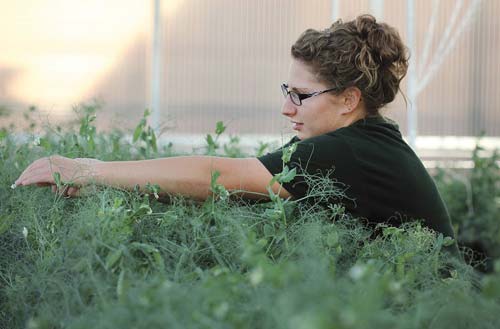While biotechnology has made big changes to some types of crop production, pulses remain underfunded.

When competing against staple crops like corn, wheat and rice, pulses get the short end of the research funding stick.
Speaking to a crowd of biotechnology insiders at the Agricultural Bioscience International Conference in Fargo, North Dakota last week, Professor Irvin Widders said the sheer variety of pulse crops guarantees funding will be spread across several research areas, if it’s provided at all.
“Funds are significantly limited, because of the large number of grain legume species and their limited relative importance around the world — compared to a simple crop such as maize or rice or something like that,” explained the director of Michigan State University’s Feed the Future Legume Innovation Lab. “But on the other hand, I’m trying to preach a message that what is unique about pulses or grain legumes is their diversity. And when we think about the global challenge going forward, we really need to talk about and exploit that diversity, because it provides us with options.”
Appealing to the innovators in the room, he challenged the traditional idea of pulses’ role in food security and nutrition.
“I want to stretch your mind a bit and not only think of these groups of crops as producers of a dry grain,” he said. “For most of these you can harvest, market and consume other parts of the plants.”
Widders noted that in several African countries, including Zimbabwe, the vegetative portion of the plant is used as a leafy green similar to spinach. Other areas also dry the leaves for future consumption.
“And it’s highly valued in their diets, and certainly nutritional,” he said. “So there is incredible diversity within these crops as well.”
Consumption of fresh pulses, either shelled or unshelled, is also an option.
However, in much of the world pulses are not reaching their genetic yield potential, according to the professor and researcher. This is attributed in part to lagging breeding programs, but also due to issues of crop management, he said.
“Because of the lack of investment in grain legumes over the years, productivity in particular has lagged behind the growth of many other crops,” Widders explained. “Here in the U.S. and Canada we manage our systems in a manner that enables us to achieve yields that are close to the genetic potential of these crops, but if I were to take you to many places in Latin America and Africa, or even Asia, the yields are maybe only 10 to 20 per cent of the genetic yield potential.”
Given the ability of pulses to fix nitrogen, that means a huge missed opportunity, particularly in developing countries where inputs are lacking. In terms of energy consumption and climate change, he said that pulses also offer an opportunity to lessen the global impact of synthetic fertilizer production.
“I think I’m speaking to the choir on this point, you know that legumes are a family of crop species, both annual crops as well as perennials, even trees, that have a symbiotic relationship with a specific bacteria, rhizobial bacteria that take nitrogen gas from the air and convert it into ammonium, which can be then absorbed by the plant to produce protein,” he said, adding current production of synthetic nitrogen fertilizer is estimated to consume two per cent of the world’s energy production.
“The production of synthetic nitrogen… is a very costly enterprise,” he said. “There are millions in savings here.”
While pitching organic fertilizer to a room of biotechnology experts and advocates might seem counterintuitive, Widders said diversifying inputs and freeing up resources for other uses is a part of making agriculture more resilient. He also reminded those present that synthetic fertilizers are a relatively recent development.
“I was born in the year 1950, synthetic fertilizers were not produced commercially until the 1940s, it was a post-Second World War era of industry,” he said. “Since the Second World War, our agriculture has become more and more dependent upon these synthetic fertilizers… what we need to do is go back and reflect that there was a time in agriculture that we were able to produce crops without synthetic fertilizers, and we produced more efficient crops as we learned to maximize output with contributions these legumes made.”
Agronomics aside, the expert added that pulses can also play a role in combating both under- and overnutrition across the globe. While all pulses provide high levels of protein, they also contribute to gut health and weight regulation.
“As an industry we consider grain legumes to be much more than just a protein-based food, they contain complex carbohydrates that are slow to digest… they are high in fibre and contain micronutrients that are essential for human growth,” he said.
And yet these mighty beans are still not top of mind for many research facilities, not even with 2016 being named the International Year of Pulses by the United Nations. Widders has travelled internationally, pushing governments to invest in pulse production and research, but has often encountered roadblocks.
“We had to make arguments to governments around the world to invest in this international research agenda on grain legumes, and it was very difficult when you came up against crops like maize, rice, other cereals, cassava, whatever,” he said, adding that cheap energy also plays a roll in diverting attention away from pulse crops.
Still, Widders is undeterred.
“I believe that grain legumes are the food for the future, they are nutrient rich, they promote good health, most importantly they provide income for family farms and improve their sustainability,” he said.
